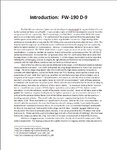courtjester140
Recruit
- 8
- Nov 23, 2008
Hello,
I'm doing a report for my aircraft structures class on the FW-190 d9. I'm specifically analyzing the wing structure. I seem to be missing some information however. I've found Soren's post quite a while back to be quite useful (comparing the 190 to a p-51), but i need the root and tip chords of the wings, as well as the wing sweep at the quarter chord. Also, the locations of the mounted machine guns along the span of the wing would be useful in load calculations. Basically i'll need information to construct a rough V-n diagram (so I'll also need max and min load factors).
If you guys have this information it would be incredibly helpful. And also if anyone is interested in a dogfight i frequent il-2 on hyperlobby as courtjester140
Thanks!!!
EDIT:
Considering the seemingly unavailability of information regarding this plane, I've decided to combine information about both this plane and the A-8 version (of which more information is readily available). Since the wing geometries are pretty much identical, the numbers should end up being pretty similar for either aircraft. Normally I wouldn't do something as stupid as this, but my professor says that its alright considering the lack of information I have, and that the process of analyzing what I know is more important.
once again, thanks!
I'm doing a report for my aircraft structures class on the FW-190 d9. I'm specifically analyzing the wing structure. I seem to be missing some information however. I've found Soren's post quite a while back to be quite useful (comparing the 190 to a p-51), but i need the root and tip chords of the wings, as well as the wing sweep at the quarter chord. Also, the locations of the mounted machine guns along the span of the wing would be useful in load calculations. Basically i'll need information to construct a rough V-n diagram (so I'll also need max and min load factors).
If you guys have this information it would be incredibly helpful. And also if anyone is interested in a dogfight i frequent il-2 on hyperlobby as courtjester140
Thanks!!!
EDIT:
Considering the seemingly unavailability of information regarding this plane, I've decided to combine information about both this plane and the A-8 version (of which more information is readily available). Since the wing geometries are pretty much identical, the numbers should end up being pretty similar for either aircraft. Normally I wouldn't do something as stupid as this, but my professor says that its alright considering the lack of information I have, and that the process of analyzing what I know is more important.
once again, thanks!




